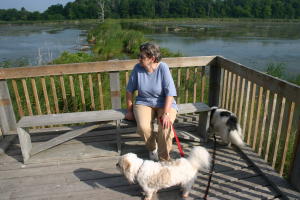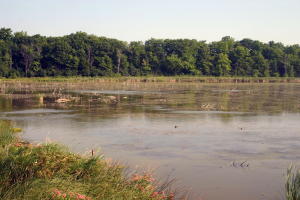Prince Edward County, Ontario, Canada
Beaver Meadow Wildlife Management Area
BEAVER MEADOW WILDLIFE MANAGEMENT AREA

Anyone who sets foot in Beaver Meadow Wildlife Management Area can’t help but be impressed by this extraordinary wetland. From nesting wood ducks, Canada geese and ospreys, to woodland flowers, salamanders and under water inhabitants, this popular conservation area has it all.
Purchased in 1970, this was the first piece of property obtained by the Prince Edward Region Conservation Authority. I had the pleasure of being involved with PERCA when the property was purchased, and one of the first projects I remember being a part of was the erection of over 30 nesting boxes for wood ducks. A variety of fruit and seed bearing trees was also planted to improve cover and food for small birds and mammals. Some of these trees and shrubs were black walnut, silver maple, white cedar, caragana, highbush cranberry, multiflora rose and pin cherry. The results of these efforts can be seen as one drives into either of the parking lots.
As one takes to the trails to explore its offerings, history enthusiasts may wonder about the presence of foundation ruins, causeway remains and other subtle hints about a past life at Beaver Meadow. What took place here before the beaver, the herons and the meandering walking trails?
If visitors happened upon the area during the early years of the twentieth century, they would have witnessed a short but intense period of human activity at Beaver Meadow. Purchased by the McMullen family in 1910, the area soon blossomed into a hive of activity. In fact, the inquisitive George McMullen gained such a reputation for experimenting with various enterprises, it has been difficult through the years separating fact from fiction.
It seems certain, however, judging from the ruins of the dam and causeway, that the McMullens were involved in some sort of water control measures. From the size of the remaining concrete as one crosses the creek on the trail, the dam must have been an impressive structure. Although much of the original dam has collapsed, water control at Beaver Meadow is still possible by means of a water control weir built in cooperation with Ducks Unlimited in the early 1980s.

Various endeavours were undertaken by the industrious McMullens including the growing of celery, ginseng, mushrooms and turnips, producing maple syrup and raising chickens. As well, a machine shop, drying kiln, celery storeroom, summer house, dining hall, and a barn were constructed. The remaining foundations, now claimed by tangles of vegetation, attest to the intense activity.From dried eggs to manufacturing explosives, from condensed milk to food drying, the McMullens dabbled in creative technology far in advance of their time. But of all the projects undertaken by this innovative family, the preservation of railway ties with a creosote oil mixture, made from the wood tar of beech trees, would seem to have been the most viable project. When G.W. McMullen died in 1915, the family business assumed a more conservative nature.
Today, this 220-acre area is still very much the focus of activity as it was in the early 1900s. The diverse ecology system comprising the wetland which takes up more than 75% of the total area, and the savannah and the woodland, has made the area popular with school groups and naturalists. During a flora and fauna survey conducted there in 1992, more than 330 species of plants were tallied, among them, eight species of ferns and horsetails, 22 grasses and sedges, 60 trees and shrubs, 16 aquatic plants, and 33 species of fungi. The crew also found 10 species of fish, 14 species of herptiles, 40 species of insects and spiders, 12 mammals, and 64 species of summer resident birds.
Unfortunately, due to financial constraints over the years, many of the original trails that wound their way through an area of specially planted wildlife shrubs, and on over to a remote section where a few of the historic foundations may be found, are no longer maintained. However, from the parking lot a walking trail of approximately .5 km crosses veers off from the parking lot to the left where a foot bridge allows hikers to cross the creek and the remains of the original McMullen dam. From there, the trail goes through a dense forest of conifers and mixed hardwoods. Passing the west end of the weir, the trail follows the edge of the water, ultimately ending at a lookout tower where one can have a panoramic view of the open swamp. This trail offers exceptional birding, often producing rose-breasted grosbeaks, wood thrushes, red-bellied woodpeckers and great crested flycatchers. Wildflowers abound along this stretch, and plants such as wild ginger, trilliums, pinesap, Indian pipe, marsh marigold and trout lily can be found.
If hikers retrace their steps, they can cross the weir and hook up with another trail which follows the other side of the water for a short distance to another lookout. This trail also passes through the edge of a deciduous woods, and many of the same birds can be found here. Rather than crossing back over the weir o the return trip, alternatively hikers can take the short access road from the weir which ends up in the parking lot.
Hikers should be conscious of the fact that this is a wildlife management area, and duck hunting does take place in the fall of the year. Also, a section of the trail forms part of a snowmobile trail, and hikers can easily and inadvertently wander off onto a branch of this route while walking the trails. If hikers stay on the trails close to the water’s edge, there should be no confusion, although the snowmobile trails do offer some interesting habitat.
Directions: From the traffic lights at the west end of Picton (at the L.C.B.O), take County Road 10 (Lake Street), and follow for five kilometres. At County Road 11, turn right and follow for 1 km to entrance.
PHOTO CREDITS:
1) A visitor relaxes on the observation deck overlooking the wetland at the end of one of the trails
photo by Terry Sprague (July, 2005)
2) An overview of the wetland at Beaver Meadow where wood ducks often can be seen
photo by Terry Sprague (July, 2005)